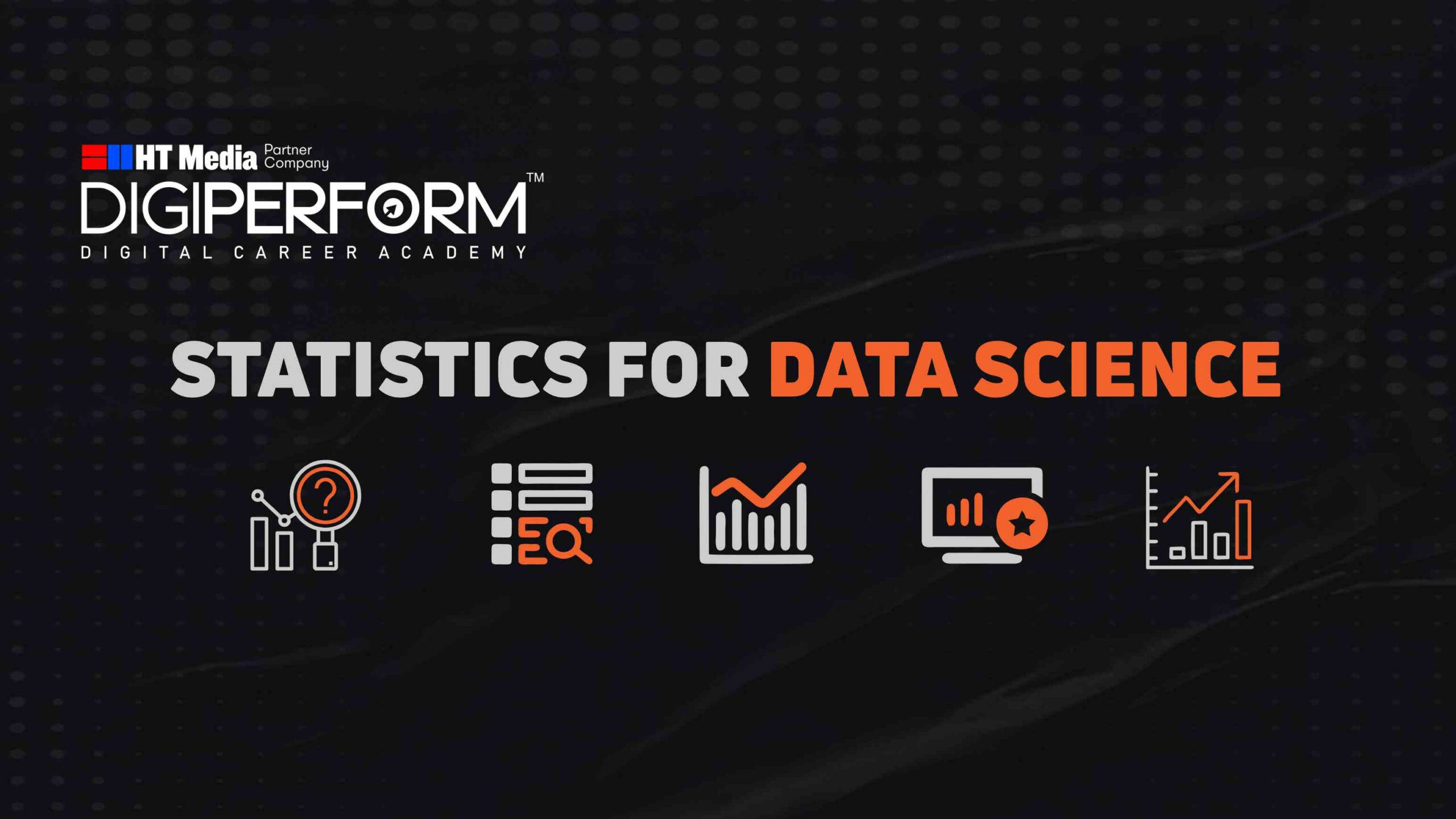Master
Data Science Courses
India’s Only Data Science Training Program created to help you to build a successful career in Data Science from scratch.
Statistics For Data Science
Statistics is a mathematical science about the collection, presentation, analysis, and interpretation of data. It’s widely used to understand the complex problems of the real world and simplify them to make well-informed decisions. Several statistical principles, functions, and algorithms can be used to analyze primary data, build a statistical model, and predict the outcomes.
The Ways of Doing Analysis
An analysis of any situation can be done in two ways. Statistical analysis or a non-statistical analysis.
Statistical Analysis:
The science of collecting, exploring, and presenting large amounts of data to identify patterns and trends. Statistical analysis is also called quantitative analysis.
Non-Statistical Analysis:
Provides generic information and includes text, sound, still images, and moving images. Non-statistical analysis is also called qualitative analysis.
Although both forms of analysis provide results, statistical analysis gives more insight and a clearer picture, a feature that makes it vital for businesses.
Categories of Statistics
There are two major categories of statistics, descriptive statistics and inferential statistics.
Descriptive Statistics:
It helps organize data and focuses on the main characteristics of the data. It provides a summary of the data numerically or graphically. Numerical measures such as average, mode, standard deviation or SD, and correlation are used to describe the features of a data set. Suppose you want to study the height of students in a classroom. In the descriptive statistics, you would record the height of every person in the classroom and then find out the maximum height, minimum height, and average height of the population.
Inferential Statistics:
Generalizes the larger data set and applies probability theory to conclude. It allows you to infer population parameters based on the sample statistics and to model relationships within the data. Modeling allows you to develop mathematical equations which describe the interrelationships between two or more variables. Consider the same example of calculating the height of students in the classroom. In inferential statistics, you would categorize height as tall, medium, and small and then take only a small sample from the population to study the height of students in the classroom. The field of statistics touches our lives in many ways from the daily routines in our homes to the business of making the greatest cities run.
Various Statistical Terms
The effects of statistics are everywhere. There are various statistical terms that one should be aware of while dealing with statistics.
Population, sample, variable, quantitative variable, qualitative variable, discrete variable, continuous variable.
- Population: This is the group from which data is to be collected.
- Sample: Is a subset of a population.
- Variable: A feature that is characteristic of any member of the population differing in quality or quantity from another member.
- Quantitative Variable: A variable differing in quantity is called a quantitative variable, for example, the weight of a person, and the number of people in a car.
- Qualitative Variable: A variable differing in quality is called a qualitative variable or attribute, for example, color, the degree of damage to a car in an accident.
- Discrete Variable: In which no value can be assumed between the two given values, for example, the number of children in a family.
- Continuous Variable: In which any value can be assumed between the two given values, For example, the time taken for a 100-meter run.
Types of Statistical Measures
Typically there are four types of statistical measures used to describe the data. They are
- Measures of frequency,
- Measures of central tendency,
- Measures of spread,
- Measures of position.
Statistical Analysis System
SAS, provides a list of procedures to perform descriptive statistics. PROC CONTENTS, PROC MEANS, PROC FREQUENCY, PROC UNIVARIATE, PROC GCHART, PROC BOXPLOT, PROC GPLOT, PROC PRINT. It prints all the variables in a SAS data set.
PROC CONTENTS. It describes the structure of a data set.
PROC MEANS. It provides data summarization tools to compute descriptive statistics for variables across all observations and within the groups of observations.
PROC FREQUENCY. It produces one-way to n-way frequency and cross-tabulation tables. Frequencies can also be an output of a SAS data set.
PROC UNIVARIATE. It goes beyond what PROC MEANS does and is useful in conducting some basic statistical analyses and includes high-resolution graphical features.
PROC GCHART. The GCHART procedure produces six types of charts, block charts, horizontal vertical bar charts, pie-donut charts, and star charts. These charts graphically represent the value of a statistic calculated for one or more variables in an input SAS data set. The ched variables can be either numeric or character.
PROC BOXPLOT. The BOXPLOT procedure creates a side-by-side box-and-whisker plot of measurements organized in groups. A box-and-whisker plot displays the mean, quartiles, and minimum and maximum observations for a group.
PROC GPLOT. GPLOT procedure creates two-dimensional graphs, including simple scatter plots, overlay plots in which multiple sets of data points are displayed on one set of axes, plots against the second vertical axis, bubble plots, and logarithmic plots.
Hypothesis Testing in Statistics
The population of hypothesis testing is to choose between two competing hypotheses about the value of a population parameter. For example, one hypothesis might claim that the wages of men and women are equal, while the other might claim that women make more than men. Hypothesis testing is formulated in terms of two hypotheses.
- The Null Hypothesis is referred to as H-null. An alternative hypothesis, which is referred to as H-1. The null hypothesis is assumed to be true unless there is strong evidence to the contrary.
- The Alternative Hypothesis is assumed to be true when the null hypothesis is proven false.
Hypothesis Testing Procedures
Let’s learn about hypothesis testing procedures. There are two types of hypothesis testing procedures. They are parametric tests and non-parametric tests.
Parametric Tests: In statistical inference or hypothesis testing, traditional tests such as t-tests and ANOVA are called parametric tests. They depend on the specification of a probability distribution except for a set of free parameters. In simple words, you can say that if the population information is known completely by its parameter, then it is called a parametric test.
Non-Parametric Tests: If the population or parameter information is not known, and you are still required to test the hypothesis of the population, then it’s called a nonparametric test. Nonparametric tests do not require any strict distributional assumptions. There are various parametric They are as follows. t-test, ANOVA, chi-squared, linear regression. Let’s understand them in detail.
- T-Test. a t-test determines if two sets of data are significantly different from each other. The t-test is used in the following situations. To test if the mean is significantly different than a hypothesized value. To test if the mean for two dependent or paired groups is significantly different.
- ANOVA. anova is a generalized version of the t-test and is used when the mean of the interval-dependent variable is different from the categorical independent variable. When we want to check the variance between two or more groups, we apply the ANOVA test.
- Chi-square. Chi-square is a statistical test used to compare observed data with data you would expect to obtain according to a specific hypothesis.
Linear regression. There are two types of linear regression, simple linear regression and multiple linear regression. Simple linear regression is used when one wants to test how well a variable predicts another variable. Multiple linear regression allows one to test how well multiple variables, or independent variables, predict a variable of interest. When using multiple linear regression, we additionally assume the predictor variables are independent.For example, finding relationship between any two variables, say sales and profit, is called simple linear regression. Finding relationship between any three variables, say sales, cost, telemarketing, is called multiple linear regression.
Nature of the Variables
Before you perform any statistical tests with variables, it’s significant to recognize the nature of the variables involved. Based on the nature of the variables, it’s classified into four types. They are categorical or nominal variables, ordinal variables, interval variables, and ratio variables.
Nominal variables are ones which have two or more categories, and it’s impossible to order the values. Examples of nominal variables include gender and blood group.
Ordinal variables have values ordered logically. However, the relative distance between the two data values is not clear. Examples of ordinal variables include considering the size of a coffee cup, large, medium, and small, and considering the ratings of a product, bad, good, and best.
Interval variables are similar to ordinal variables, except that the values are measured in a way where their differences are meaningful. With an interval scale, equal differences between scale values do have equal quantitative meaning. For this reason, an interval scale provides more quantitative information than an ordinal scale.
The interval scale does not have a true zero point. A true zero point means that a value of zero on the scale represents zero quantity of the construct being assessed. Examples of interval variables include the Fahrenheit scale used to measure temperature and distance between two compartments in a train.
Conclusion:
I hope you like all the information we have given you in this article about Statistics for Data science.
Before I end, I would like to say that if you Want to make a career in this field of achievement you can do an Online Data science course (Master Certification Program in Analytics, Machine Learning, and AI) from Digiperform. India’s Only Most Trusted Brand in Digital Education
In this Data science online course You will solve 75+ projects and assignments across the project duration working on Stats, Advanced Excel, SQL, Python Libraries, Tableau, Advanced Machine Learning, and Deep Learning algorithms to solve day-to-day industry data problems in healthcare, manufacturing, sales, media, marketing, education sectors making you job ready for 30+ roles.
And to get your dream job Digiperform’s dedicated placement cell will help you with 100% placement assistance.
FAQs:
What is the role of statistics in data science?
Statistics in data science plays a crucial role in extracting meaningful insights from data. It involves the collection, analysis, interpretation, presentation, and organization of data to make informed decisions and predictions. By using statistical techniques, data scientists can identify patterns, trends, and relationships within datasets.
How is descriptive statistics different from inferential statistics in data science?
Descriptive statistics focuses on summarizing and describing the main features of a dataset, such as mean, median, and standard deviation. In contrast, inferential statistics involves making predictions or inferences about a population based on a sample of data. Data scientists use both types of statistics to gain a comprehensive understanding of the data they are working with.
What is the significance of hypothesis testing in data science?
Hypothesis testing is a statistical method used in data science to evaluate and validate assumptions about a population based on sample data. It helps data scientists make decisions, draw conclusions, and assess the significance of observed patterns. This process is essential for ensuring the reliability and generalizability of findings in data analysis.
How does regression analysis contribute to predictive modeling in data science?
Regression analysis is a statistical technique employed in data science for modeling the relationship between a dependent variable and one or more independent variables. In predictive modeling, regression helps identify and quantify the influence of different factors on the outcome variable. This allows data scientists to build models that can make accurate predictions and understand the impact of specific variables on the target variable.
Why is it important to understand probability in data science?
Probability is fundamental to data science as it provides a framework for dealing with uncertainty and randomness. Data scientists use probability theory to assess the likelihood of events, make predictions, and quantify uncertainties in their analyses. Understanding probability is crucial for building robust models, making informed decisions, and effectively communicating the uncertainty associated with data-driven insights.











